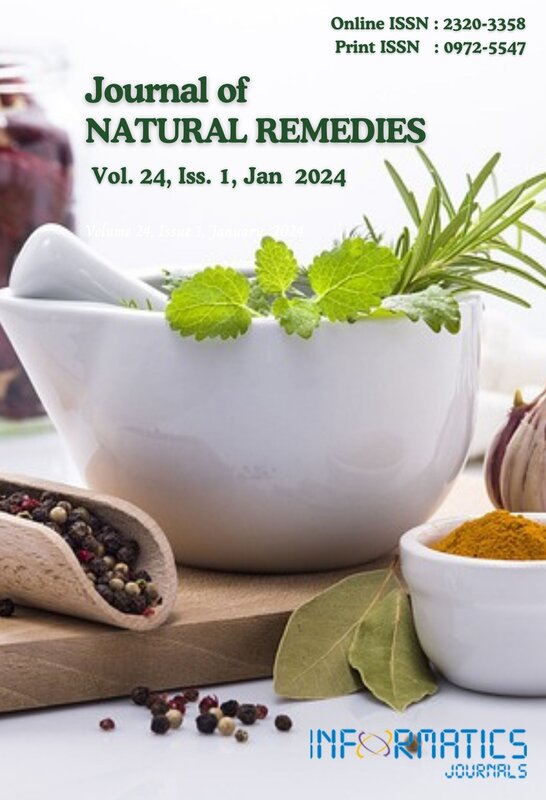Ayurvedic Management of Bell’s Palsy - A Case Report
DOI:
https://doi.org/10.18311/jnr/2024/34447Keywords:
Ardita Vata, Bell’s Palsy, Dasamool Kashaya Dhooma, Nasya, Ksheerbala Taila, VatavyadhiAbstract
Background: Bell’s palsy is a sudden and unexplained condition characterized by temporary weakness or paralysis of one side of the face or the areas supplied by the facial nerve, resulting from the paralysis of the peripheral facial nerve. It can be caused by various factors varying from trauma, infection, ischemia, or inflammation that affects the seventh cranial nerve. In Ayurveda, Bell’s palsy can be compared to Ardita Vata, a condition described within the realm of Vatavyadhi Chapter mentioned in various Samhitas and its treatment has also been explained in detail in Samhitas. Aim and Objectives: The effectiveness of different Kriyakalpa techniques, as well as oral medication, was studied and observed in detail in this medical study by investigating a patient with Acute Bell’s palsy. The main goal was to assess the outcomes of these interventions which is a much better option than Allopathic steroids. Settings: A fresh case of Bell’s palsy that had occurred only 24 hours ago was treated at the outpatient Department of Shalakya Tantra OPD at Dr. D. Y. Patil College of Ayurved and Research Centre, Pimpri, Pune. The patient’s condition was evaluated before and after receiving the prescribed treatment. Treatment Plan: The individual received Mukhabhyanga (facial massage) with Mahamasha oil, Nadi Sweda (sweating therapy) with Dashamoola herbal decoction fumigation, Marsha Nasya (intranasal treatment) with Panchendriya vardhana oil, and Netratarpana with Ksheerabala oil for seven days in addition to Shamana medication for one month. Result: Significant progress was noted according to the House-Brackmann scale. Following 15 days of therapy, the scale decreased from IV to III, and subsequently to II and I after the 30th day of monitoring. Conclusion: This study demonstrates encouraging and speedy outcomes of Ayurvedic therapy by taking into account factors of Vatavyadhi, particularly Ardita Vata, without exhibiting any complexities.
Downloads
Metrics
Downloads
Published
How to Cite
Issue
Section
License
Copyright (c) 2024 Aiswarya Krishna, Mayur V. Shiralkar, Anand Kale, Pallavi Jagtap, Santosh Rahinj, Shubhangi Kale (Author)

This work is licensed under a Creative Commons Attribution 4.0 International License.
Accepted 2023-09-16
Published 2024-01-01
References
Gorthi SP, Venkataraman S. Disorders of cranial nerves. In: Munjal YP, editor. API Textbook of Medicine vol 2, 9th edition. Mumbai: The Association of Physicians of India; 2012. p. 1397-8.
Adams RD, Victor M. Principles of neurology, 5th edition. New York: McGraw-Hill, Health Professions Division; 1993. p. 1175-7.
Shastri AD. Nidanasthana 1/68. Sushruta Samhita, Part 1. Varanasi: Chaukhamba Sanskrit Sansthan; 2013. p. 303.
Gorthi SP, Venkataraman S. Disorders of cranial nerves. In: Munjal YP, editor. API Textbook of Medicine vol. 2, 9th edition. Mumbai: The Association of Physicians of India; 2012. p. 1398.
Walker HK. Cranial nerve VII: The facial nerve and taste. In: Walker HK, Hall WD, Hurst JW, editors. Clinical Methods: The History, Physical and Laboratory Examinations, 3rd edition, Chapter 62. Boston: Butterworths; 1990.
Walker HK. The suck, snout, palmomental and grasp reflexes. In: Walker HK, Hall WD, Hurst JW, editors. Clinical Methods: The history, physical and laboratory examinations, 3rd edition, Chapter 71. Boston: Butterworths; 1990.
House JW, Brackmann DE. Facial nerve grading system. Otolaryngology. Head Neck Surgery. 1985; 93:146-7. https://doi.org/10.1177/019459988509300202 DOI: https://doi.org/10.1177/019459988509300202
Agnivesa, Charaka Samhita, Text with English translation and critical exposition. In: R K Sharma, V B Das, editors. Chakrapani Dutta’s Ayurveda Deepika, Vol 5, Chikitsa stana, Chaukhamba Sanskrit Series, Varanasi; 2004. p. 31.
Acharya YT. Vimanasthana, 28/84. Charaka Samhita. 1st ed. Varanasi: Choukhamba Surabharati Prakashan; 2000. p. 620.
Shastri KN, Chaturvedi GN. Chikitsasthana, 28/99-100. Charaka Samhita. 1st ed. Varanasi: Chaukhamba Bhartiya Academy; 2007. p. 795.
Shastri AD. Chikitsasthana, 5/22. Sushruta Samhita. 2nd ed. Varanasi; Chaukhamba Sanskrita Sansthan; 2014. p. 43.
Mishra SN. Jwaradhikar Dashamoola Kwath. Chapter 5/233 - 235. In: KGD Sen, Bhaishajyaratnavali - edited with Siddhiprada Hindi Commentary. Varanasi: Chaukhamba Surbharti Prakashan; 2019. p. 105.
Vagbhata, Astanga Samgraha, Sutra sthana, 29th chapter, 2nd sloka, Vol 1, Translation by K. R. Srikantha Murthy, Chaukhamba Orientalia. 2018. p. 511.
Kashyapa Samhita edited by P V Tewari English translation and commentary, Chaukhamba viswabharati Publication, Kalpasthana Chap; 2013. p. 347.
Prabhakara RG. Taila Yoga Prakaranam, 123, Ch. 18. Sahasrayogam Sanskrit Text with English Translation and Prabhakara Vyakhyanam. 1st ed. New Delhi: Chaukhamba Sanskrit Sansthan; 2016. p. 559.
Susruta’s Susruta Samhita Sutrasthana, 45/112-113, with Nibandhasamgraha commentary of Dalhana, edited by Acharya VJT, Varanasi: Chowkhamba Krishnadas Academy, Reprint edition; 2004.
Pandey GS. Dugdha Varga, verse 7-8. In: K C Chunekar, Sri Bhavamishra; Bhavaprakash Nighantu - commentary (Hindi). Varanasi: Chaukhamba Bharati Academy. Reprint edition; 2015. p. 742.
Pandey GS. Taila Varga, verse 2-5. In: K C Chunekar, Sri Bhavamishra; Bhavaprakash Nighantu - commentary (Hindi). Varanasi: Chaukhamba Bharati Academy. Reprint Edition; 2015. p. 763.
Munhall AC, Johnson SW. Dopamine mediated actions of ephedrine in the rat substantia nigra. Brain Research. 2006; 1069:96-103. https://doi.org/10.1016/j.brainres.2005.11.044 DOI: https://doi.org/10.1016/j.brainres.2005.11.044
Pandey GS. Guduchyadi Varga, verse 144. In: K C Chunekar. Sri Bhavamishra; Bhavaprakash Nighantu- commentary (Hindi). Varanasi: Chaukhamba Bharati Academy. Reprint edition; 2015. p. 351.
Kanth VR, Diwan PV. Analgesic, anti-inflammatory and hypoglycemic activities of Sida cordifolia. Phytotherapy Research. 1999; 13:75-7. https://doi.org/10.1002/(SICI)1099- 1573(199902)13:1<75::AID-PTR387>3.0.CO;2-F DOI: https://doi.org/10.1002/(SICI)1099-1573(199902)13:1<75::AID-PTR387>3.3.CO;2-6
Gupta K, Mamidi P. Some efficacious Ayurvedic Panchakarma procedures in children with cerebral palsy. International Journal of Alternative and Complementary Medicine. 2018; 11(1):37-42. https://doi.org/10.15406/ijcam.2018.11.00344 DOI: https://doi.org/10.15406/ijcam.2018.11.00344
Palsineuron, Proprietary Product. Manufactured by GMP certified SG Phytopharma Pvt Ltd., Kolhapur, Maharashtra, India. Available from: https://www.sgphyto.com/product/ palsinuron-capsules/#1518236090001-4a0f90c1-23e97260- dd594b54-2b47

 Aiswarya Krishna
Aiswarya Krishna









 0.35
0.35 24
24 0.161
0.161